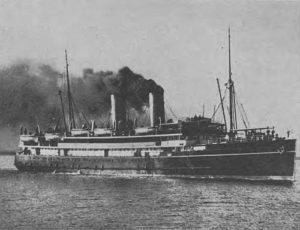- Author
- Millar, Jack
- Subjects
- History - general
- Tags
-
- RAN Ships
- None noted.
- Publication
- August 1972 edition of the Naval Historical Review (all rights reserved)

At frequent intervals a British Freighter, the Port Victor, sails unassumingly into the Port of Melbourne on her workmanlike task of trading regularly between Australia and other world ports. Like many a famous exserviceman in civilian dress, no one would suspect the colourful wartime history and achievements of this sturdy cargo carrier, nor is it generally known that this ship formerly carried a name made famous not only in two world wars but also a household word not so many years ago to thousands of Australians travelling between the Port of Melbourne and Tasmanian ports. It is a far cry from England to Australia, from Melbourne to Archangel and from Bass Strait to the Arctic Ocean, but the name Nairana links them all.
IT WAS A SHIP named Nairana – actually the first ship carrying the name – whose port of registry and home port was Melbourne, which endeared herself to people generally as the ferry which plied the sometimes placid but more often stormy Bass Strait with such regularity between the two world wars.
For the greater part of World War II, she was the only passenger link between Tasmania and the mainland, and many a serviceman going on leave has a soft spot in his heart for the old Nairana speeding him home to Tasmania.
Indeed her end provided an anticlimax. The grand old lady, as if thumbing her nose in defiance of those who wished to tow her away for scrap, broke free from her anchorage in Port Phillip and drifted ashore at Port Melbourne in February 1951. She became so deeply embedded in the sand that all efforts to tow her off proved futile.
The thousands who travelled on her must have read with pride the brass tablet in her saloon epitomising her war record: HMS Nairana, flying the flag of Rear Admiral T.W. Kemp, CIE, was instrumental in the capture of Archangel in August 1918, engaging the six-inch batteries at the mouth of the river with her guns and seaplanes, and anchoring off the city, destroying the Bolshevik forts. By means of bombs and gunfire directed from a seaplane sent up from her deck, she destroyed an armed vessel in which the Bolshevik Chancellor of the Exchequer was escaping with the Bolshevik treasury on board. Until October 1918 HMS Nairana controlled the northern coast of Russia, engaging the enemy with her guns and seaplanes, and landing armed blue jackets wherever necessary.
The Nairana, of 3,042 tons, was ordered by Huddart Parker Ltd. from Messrs. Denny Bros. at Dumbarton expressly for the Melbourne-Launceston trade, which, owing to the great rise and fall of the tide in the Tamar and the huge seas sometimes encountered in the Straits, demanded a vessel to suit these requirements. Not many who travelled on her could say the ‘old girl’ didn’t live up to these ideals.
Well on the way to completion when World War I broke out, her construction was left in abeyance, whilst more urgent Admiralty work was carried out, until August 1917, when the Navy took over and converted her to a seaplane carrier. Retaining her name, she thus wrote into the annals of the British Navy a name which was to be so proudly carried by a later ship converted for somewhat similar duties in the same way.
HMS Nairana arrived at Murmansk on July 19 1918, during the very confused fighting on the Russian Arctic front and at once made her presence felt. One of her seaplanes was used by a senior British Naval Officer to spy out lines of enemy approach south of Soroka.
Whilst over Parandove they were met with heavy fire from two troop trains filled with Bolshevik troops. Nothing daunted they attacked and, blazing away with the Lewis gun, succeeded in silencing the fire.

Later that month HMS Nairana, together with the light cruiser HMS Attentive and the French cruiser Admiral Aube embarked British Royal Marines and French troops and departed Murmansk to storm and capture Archangel from the Bolsheviks.




